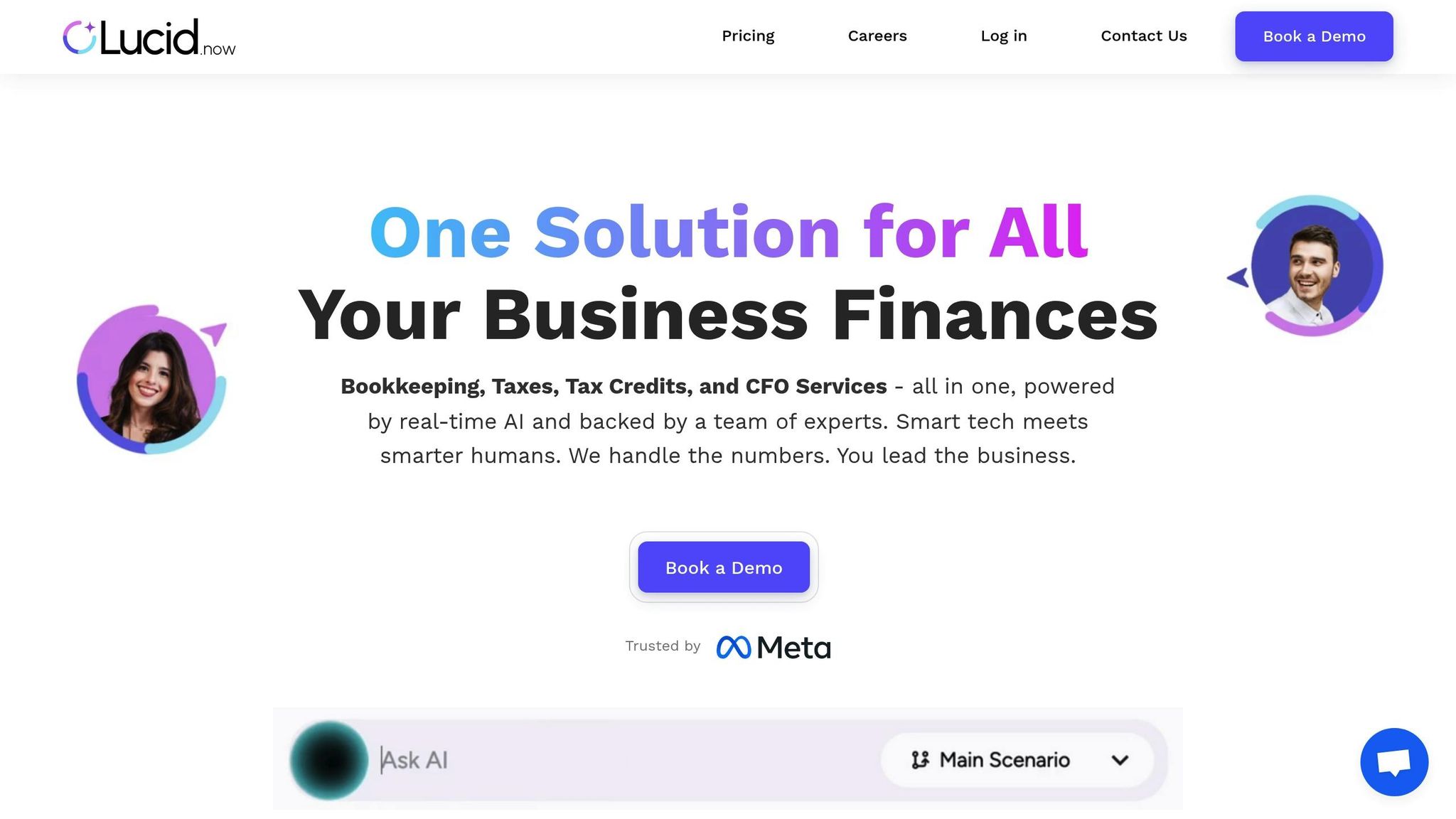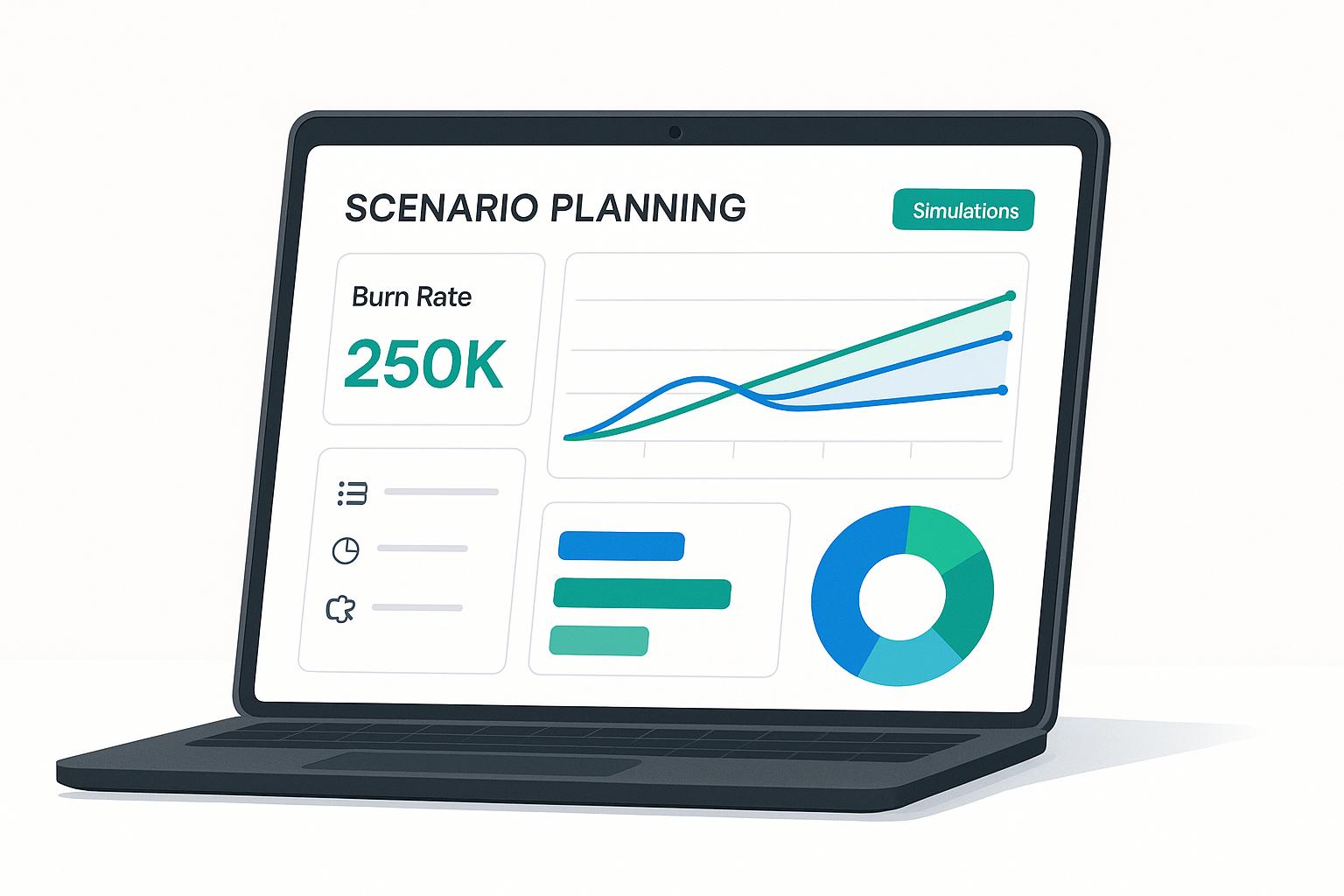AI-powered pricing helps startups solve common pricing challenges like setting the right price, responding to market changes, and analyzing customer behavior. By using machine learning, AI systems analyze massive amounts of data - such as sales history, competitor pricing, and seasonal trends - to recommend optimal prices in real time. This approach not only boosts revenue and profit margins but also reduces manual work, enabling startups to focus on growth.
Key Takeaways:
- Dynamic Pricing: AI adjusts prices automatically based on demand, inventory levels, and competitor moves.
- Data-Driven Insights: AI identifies patterns in customer behavior and market trends to refine pricing strategies.
- Automation: Reduces manual tasks, ensuring consistent and accurate price updates across platforms.
- Integration: Works seamlessly with e-commerce, CRM, and financial tools like Lucid Financials for real-time impact assessment.
For startups, implementing AI pricing requires clear goals, clean data, and integration with financial systems to measure results effectively. This shift to AI-driven pricing can lead to better decision-making, improved competitiveness, and measurable revenue growth.
Data-driven Pricing: How AI and Analytics are transforming pricing in organizations
Common Pricing Problems That Limit Revenue Growth
Startups often grapple with pricing challenges that can stifle revenue growth. These hurdles highlight the need for more adaptive, data-driven solutions like AI-powered dynamic pricing.
Fixed or Manual Pricing Methods
Relying on traditional pricing methods can hold startups back, especially when markets shift rapidly. Fixed markups or copying competitors’ pricing strategies fail to capture the unique value a product offers or respond to changing market signals. On top of that, manually adjusting prices across multiple channels is not only time-consuming but also prone to missing opportunities to maximize revenue.
Scattered or Missing Data
Smart pricing decisions need a solid foundation of integrated data, but many startups struggle with fragmented systems. Information might be scattered across CRMs, accounting software, and analytics tools, making it difficult to get a clear picture of customer behavior or past pricing performance. Gaps in data can obscure key insights, like which customer segments are most sensitive to price changes or which product features could justify higher prices. Problems like manual entry errors, duplicate records, and missing historical pricing data make it even harder to gauge how pricing affects conversion rates or customer retention.
Lack of Pricing Customization
A one-size-fits-all pricing model often leaves money on the table by failing to address the diverse needs of different customer segments. For example, a small business might skip a product if it feels priced for larger enterprises, while a low price might make a bigger company doubt the product’s quality or value. Tailoring prices to suit specific customer groups requires advanced tools that many startups simply don’t have. Geographic differences add another layer of complexity - what resonates with U.S. customers might not appeal elsewhere. Adjusting prices manually for factors like order volume or seasonal demand is impractical, often leading startups to rely on broad estimates instead of data-driven strategies. Overcoming these obstacles opens the door for AI-powered dynamic pricing, which can adapt to market changes in real time.
How AI-Driven Dynamic Pricing Works
AI-based pricing systems take revenue optimization to the next level by continuously analyzing market data and adjusting prices automatically. Unlike traditional methods that rely on intuition or fixed formulas, these systems process massive amounts of information to make real-time pricing decisions.
Data Collection and Analysis
AI pricing tools start by gathering internal data like sales history, customer behaviors, inventory levels, and profit margins to understand the business's unique dynamics. Then they incorporate external data, such as competitor pricing, industry trends, and economic indicators, to complete the market picture. These systems even factor in real-time signals, like website traffic, product search volumes, and social media sentiment about your brand or industry.
The real magic happens during the analysis phase. Machine learning algorithms identify patterns that might go unnoticed otherwise, such as how pricing varies by geography or how different customer groups respond to price changes. For instance, the system might reveal that customers in specific regions are willing to pay extra for faster shipping at certain times of the year. It can also distinguish between first-time buyers, who may be more price-sensitive, and loyal customers who prioritize value over cost. By performing cohort analysis, the AI helps businesses understand which customer segments are most responsive to price adjustments, enabling more precise and effective strategies.
This deep level of analysis empowers businesses to make immediate and well-informed pricing changes.
Real-Time Price Changes
AI systems excel at adapting prices in real time, responding to factors like inventory levels, competitor moves, and shifts in demand. These adjustments happen continuously, ensuring prices stay aligned with current conditions.
Dynamic inventory management plays a big role here. If stock levels are running low, the system may increase prices to maximize revenue from the remaining items while controlling demand. On the flip side, when inventory starts to pile up, prices can be lowered to encourage sales and avoid overstock issues.
Another key feature is demand forecasting, which uses historical data, seasonal trends, and external factors to predict when demand will rise or fall. This allows businesses to adjust prices proactively, optimizing revenue before market conditions change instead of reacting afterward.
Integration with Current Systems
AI-driven pricing systems work seamlessly with your existing tools and platforms. Through e-commerce platform integration, prices can be updated automatically across all sales channels, whether it's your website or third-party marketplaces.
These systems also connect with CRM, e-commerce, and financial platforms - like Lucid Financials - to ensure that pricing aligns with live data and broader business goals. For instance, integrating with accounting tools like Lucid Financials allows the system to factor in real-time financial metrics, cash flow needs, and profitability targets. This gives founders instant insights into how pricing decisions impact overall financial performance and ensures reports meet investor standards.
Additionally, API connections enable the pricing system to sync with inventory management, shipping, and customer service tools. This creates a unified ecosystem where pricing decisions reflect every aspect of the business, from supply chain costs to customer satisfaction. The setup process typically involves configuring data feeds, setting pricing rules, and establishing workflows for major price changes. Many modern AI platforms even offer pre-built connectors for popular business tools, making integration straightforward and efficient.
sbb-itb-17e8ec9
Key Benefits of AI-Powered Pricing for Startups
AI-powered pricing brings a host of advantages that can directly impact a startup’s growth and ability to compete. It’s not just about automating tasks - it’s about uncovering smarter ways to grow revenue and stay ahead in the market.
Revenue Growth and Profitability
AI pricing tools are designed to pinpoint the perfect price points that traditional methods might miss. By analyzing customer behavior, willingness to pay, and market trends, these systems help startups tap into their full revenue potential.
One standout feature is elasticity analysis, which tests different price levels in real time. This helps identify products that can command higher prices without scaring off customers, while also revealing when competitive pricing makes more sense.
AI also factors in every cost, from production to customer acquisition, when setting prices. This ensures each sale contributes to a healthier profit margin. On top of that, seasonal adjustments align pricing with consumer spending habits, keeping cash flow more predictable.
Better Competitiveness
With AI, startups can monitor market trends in real time, keeping a close eye on competitor pricing. This gives businesses the ability to react quickly - whether it’s taking advantage of temporary gaps in the market or adjusting prices to reflect premium conditions.
AI also enables highly targeted pricing strategies. Startups can tailor prices based on regions, customer segments, or even individual accounts. This helps them capture untapped opportunities while staying flexible enough to adapt to changing market demands.
Less Manual Work
AI automation takes the burden of pricing off startup teams. Instead of manually crunching numbers in spreadsheets or updating prices across platforms, teams can focus their energy on building better products, engaging customers, and planning for growth.
Automated pricing systems also reduce errors that often come with manual processes. They ensure consistent rule application and make updating prices across growing catalogs and channels a breeze - no extra administrative overhead required.
Another benefit is faster decision-making. AI processes pricing data and presents it in clear, actionable ways, allowing teams to respond swiftly to new market opportunities or shifts in customer behavior. Plus, integrating with tools like Lucid Financials ensures pricing aligns with cash flow, profitability, and key metrics, giving startups a clearer financial picture at a glance.
Best Practices for Implementing AI-Powered Pricing in Startups
Rolling out AI-driven pricing strategies in a startup requires a well-thought-out plan that aligns with your business objectives. Success depends on taking intentional steps to ensure your AI system delivers meaningful results from the start.
Set Clear Goals
Before jumping into AI pricing tools, define what you aim to achieve. Are you targeting a 15% revenue increase within the next quarter? Hoping to boost profit margins by 8% on core products? Or perhaps you want to undercut competitor prices by 5% while staying profitable?
Your AI strategy should be tailored to these specific goals. For example, if revenue growth is the focus, the AI should identify opportunities to test higher price points and analyze price elasticity. If improving margins is the priority, the system must account for all associated costs - like production and customer acquisition - when recommending prices.
Set measurable and time-bound targets. For instance, aim for a 15% revenue boost in three months or a $25 increase in average order value over six months. These benchmarks not only guide your AI configuration but also provide clear metrics to evaluate its success.
Consider your startup’s current position in the market. Early-stage companies might prioritize competitive pricing to establish a foothold, while more mature businesses may lean toward premium pricing strategies. Your AI pricing approach should reflect your growth stage. Clear goals also simplify data preparation and integration processes.
Prepare Data for AI Implementation
A reliable AI pricing system begins with clean and comprehensive data. Start by collecting historical sales data, customer profiles, competitor pricing, and cost structures from across your platforms.
Many startups face the challenge of scattered data - sales in one system, costs in another, and customer behavior elsewhere. Consolidate all this information into a centralized database. This might involve pulling data from your e-commerce platform, CRM, and accounting software into a unified format.
Data quality is key. Eliminate duplicates, fill gaps, and standardize formats. For example, if some products have detailed cost breakdowns but others don’t, work to make this information consistent. AI systems perform poorly with incomplete or inconsistent data sets.
Historical pricing data is particularly valuable. Analyze which price adjustments boosted sales, which hurt conversion rates, and how seasonal trends influenced demand. This context allows your AI system to make smarter predictions for future pricing.
Don’t overlook external data sources. Competitor pricing, industry benchmarks, and market research can significantly improve your AI’s decision-making. A well-rounded data foundation ensures your pricing recommendations are more precise and actionable.
Use Financial Tools like Lucid Financials

Integrating AI pricing with financial tools ensures immediate and measurable impact. Real-time financial data allows your AI system to assess how pricing changes affect cash flow, profit margins, and overall financial health - not just revenue.
For instance, when your AI suggests a price adjustment, Lucid Financials can show its impact on key metrics like gross margin or runway projections. This integration prevents short-term revenue gains from jeopardizing long-term financial stability.
Tools like Slack can enhance this process by delivering real-time financial insights. You can ask questions like, “What was the gross margin impact of last week’s price changes?” or “How does our runway look if we maintain the new pricing?” Instant answers help you refine your pricing strategy on the fly.
Investor-ready reporting is another critical feature. Investors want to see how pricing changes contribute to sustainable growth rather than temporary spikes. Lucid’s automated reports present your AI-driven pricing decisions in a format that’s clear and credible for stakeholders.
Lucid also offers AI-generated forecasts, enabling you to model different pricing scenarios. You can test how various strategies might affect your financial outlook over the next 12-18 months, ensuring your pricing decisions align with long-term growth goals.
As your startup grows - expanding into new markets or product lines - multi-entity support becomes essential. Different pricing strategies may be needed for various business units, and consolidated financial reporting helps you evaluate their overall impact efficiently.
Conclusion: Driving Revenue Growth with AI-Powered Pricing
AI-powered pricing transforms how startups optimize revenue by addressing key growth hurdles. Instead of sticking to rigid pricing models or working with incomplete data, AI introduces a flexible system that adjusts to real-time market dynamics, paving the way for increased profitability.
The shift from manual to AI-driven pricing offers undeniable advantages. Startups can see measurable improvements in revenue and profit margins. By analyzing extensive data - like customer behavior and competitor pricing - AI enables smarter, more effective pricing decisions.
To maximize these benefits, having a solid implementation plan is crucial. This means setting clear revenue goals, consolidating data effectively, and integrating AI tools with existing financial systems. Pairing AI pricing with platforms like Lucid Financials gives startups a clearer understanding of how pricing decisions impact cash flow, runway, and overall financial health.
Beyond financial gains, AI pricing also lightens the operational load for founding teams, providing investor-ready insights with less manual effort. This combination of efficiency and transparency not only supports sustainable growth but also strengthens a startup’s position when seeking funding.
For founders looking to scale, AI-powered pricing creates a dynamic revenue model that grows alongside your business. By automating pricing decisions and integrating financial tools, you free up time to focus on strategy and long-term agility - key ingredients for sustained success.
FAQs
How can startups ensure their data is accurate and ready for AI-driven pricing?
To get the most reliable results from AI-driven pricing, startups need to prioritize data accuracy and consistency. This means setting up regular routines for validating, cleaning, and standardizing data to catch and fix any errors. It's also crucial to keep data sources current to align with shifting market trends. Automated tools can be a big help here, quickly spotting and resolving anomalies. When your data is clean and well-organized, AI can create pricing strategies that are far more precise and effective.
What challenges might startups face when integrating AI-powered pricing systems into their existing tools?
Startups often face a range of challenges when trying to integrate AI-powered pricing systems into their existing tools and platforms. One of the biggest hurdles is dealing with data quality and reliability. If the data being fed into the system is inaccurate or incomplete, the AI’s insights can become unreliable, undermining its value.
Another issue is compatibility. Many startups rely on older, legacy systems that don’t always play well with modern AI technologies, making the integration process more complicated than expected.
Beyond technical barriers, organizational resistance to change can also slow things down. Teams might be reluctant to embrace new technology, especially if they’re unsure how it will impact their workflows. On top of that, startups may require specialized technical expertise to implement and maintain the system effectively, ensuring it continues to provide accurate and actionable insights over time.
These challenges, while significant, can be addressed with careful planning and the right resources. By tackling these obstacles head-on, startups can maximize the benefits of AI-powered pricing systems.
How does AI-powered dynamic pricing help startups optimize revenue and adapt to market changes?
AI-driven dynamic pricing gives startups a powerful way to boost revenue by analyzing large datasets to uncover customer segments and market trends. This approach allows businesses to tweak prices in real-time, factoring in demand, competitor pricing, and customer behavior.
With pricing strategies shaped by current market conditions, startups can strike a balance between profitability and competitiveness. By relying on AI, businesses gain the flexibility to adapt quickly to changes while addressing the unique needs of their customer base.


